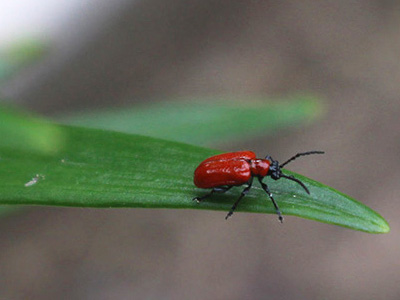
By Krishna Ramanujan, reposted from CALS News 2017-07-10]:
Many gardeners across New York state have given up on growing lilies, thanks to the lily leaf beetle, which has devastated the plants in many areas statewide, across the Northeast and in Canada.
But now researchers have released parasitoid wasps as a natural control and alternative to pesticides at three test sites across the state through a project of the New York State Integrated Pest Management (NYS IPM) program at Cornell’s College of Agriculture and Life Sciences (CALS), working with Cornell Cooperative Extension (CCE).
The small, bright red lily leaf beetle (Lilioceris lilii) feeds on native and cultivated oriental lily varieties. Their larvae are small grubs that are less than 1 millimeter when first hatched and grow to roughly one-and-a-quarter centimeters (or half-an-inch), and they cover themselves in fecal matter, which may make them taste foul to birds and other predators.
The three types of tiny parasitoid wasps (Tetrastichus setifer, Lemophagus errabundus and Diaparsis jucunda) specifically target lily leaf beetles by laying eggs in the beetle larvae. The beetle larvae drop to the ground to pupate, but when they have been parasitized, adults never emerge because the wasps pupate within the beetle pupae, killing them and emerging in the spring.
Entomologists at the University of Rhode Island began evaluating the native-European wasps in 1999 to make sure they were safe for other insects and had them approved for release by the United States Department of Agriculture.

Project researchers – led by the NYS IPM ornamentals team, Brian Eshenaur and Elizabeth Lamb – will collect beetle larvae at the test sites next June and send them to the University of Rhode Island to check if they are parasitized and determine whether the wasps overwintered and are establishing themselves in New York state.
“It’s not a fast process, but it has the advantage in that if those wasps get established in New York, then we have continuing control that doesn’t require any pesticides,” said Lamb. If the wasps do establish themselves, lily leaf beetle levels could decline enough for lilies to thrive.
A 2015 survey of CCE educators by Eshenaur found that lily leaf beetles were present in 30 New York counties, with 73 percent of those counties reporting high damage. Also, 58 percent of those surveyed said that lily sales were down and consumers had stopped growing lilies in their areas.
The wasps have been released at CCE sites in Putnam and Albany counties, and at Cornell’s Long Island Horticultural Research and Extension Center. An additional release will take place at the Erie County CCE. Before releasing the wasps, the researchers collected beetle larvae at those sites to check whether wasps that had been released and established in other states may have moved into New York and already parasitized the beetle larvae.
Eshenaur and Lamb received a three-year, $60,000 grant from CALS in 2016 to release the parasitoid wasps and gather information on whether the wasps will establish themselves in the state. They will also do outreach about the project and create a fact sheet on the wasps. “The project is an important interaction between IPM on campus working with counties and having that move out to the general population,” Lamb said. “It’s a way of getting the word out about the concepts of integrated pest management, so that people realize there are alternatives in some cases.”
Lisa Tewksbury, a research associate at the University of Rhode Island’s Biological Control Lab, leads efforts there to produce the wasps, get them approved and test larvae to see if they are parasitized.


